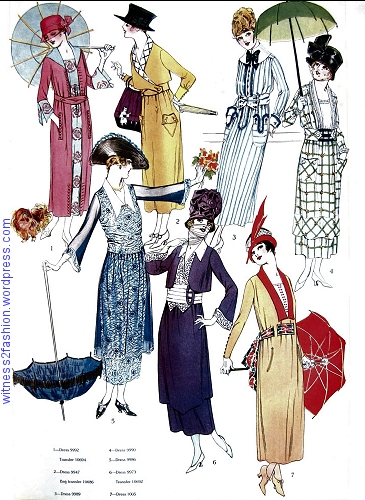
Dresses, skirts and blouses, Butterick patterns in Delineator magazine, July 1918, page 52.
This color page of dresses (and blouses and skirts) from Delineator magazine shows a change in silhouette, from full to narrower skirts. (Tubular Twenties ahead!) Here are designs by Gabrielle Chanel, dated 1916 [from Doris Langley Moore’s Fashion through Fashion Plates via Quentin Bell] :

And here is a Delineator sketch of an influential Chanel suit from January 1925 — very a different silhouette.

(You can read about the “Tubular Twenties” here.)
I’ll show the July 1918 images in greater detail below, but first, a few words about underwear and the “ideal” figure.

Ideal fashion figures in July 1918 were thick in the waist, droopy in the bust — even with the model’s shoulders thrust back — and slightly swaybacked.
I’m always unnerved by the emphasis on thick waists and low busts of this period. (How is is possible for a slender young woman to have such a low bust? — The explanation is two-fold: the exaggerations of fashion illustrators, and 1917-1918 corsets and brassieres.)
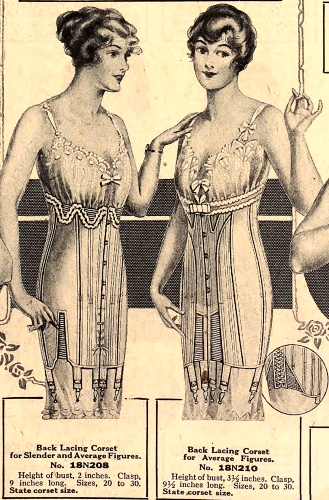
Corsets for Fall, 1918. Sears catalog.
The brassiere of the World War I era was more likely to smash the breasts than to lift them. The corset of the “teens” did not reach (or support) the breasts at all. It extended down over the thighs and pushed the body very flat in front, causing a posture which made the waist higher in the back and lower in the front, as you can see from these 1917 skirt illustrations.

Women’s skirts, Perry Dame catalog, 1917. The waistlines dip low in front and rise high in back.

Skirts, blouses and dresses, from July 1918 show the oddly high waist in back.
The beautiful vintage blouses of this period (sometimes called “Armistice blouses”) are often so short in back that they have to have a tail of fabric added before they can be worn without the corset. Otherwise, they won’t stay tucked in.

This vintage “Armistice blouse” is shorter in back than in front, even allowing for its position on the hanger. It has not been altered; the ties are original.
The thick waists of the WW I era can be interpreted as a reaction to the tiny waists of the previous generation (Here’s Princess Maud in 1906.) (We tend to reject the clothes our mothers wore. Imagine wearing a 1926 dress in 1938…. or a 1906 dress in 1918.)
The page of color fashions (p. 52) had a half-page of black and white ones, along with all their descriptions, on page 53.

Butterick patterns from page 53, July 1918. Nos. 9932, 1035, and 1037. The two on the right are heavily embroidered.
This month in 1918 marked the start of a new Butterick pattern numbering sequence, from 9999 to the 1000s.
I’m afraid the colors are overexposed in my photos, but still worth looking at. For those who want details, I’ll show each outfit with its original pattern description at the bottom of this post.
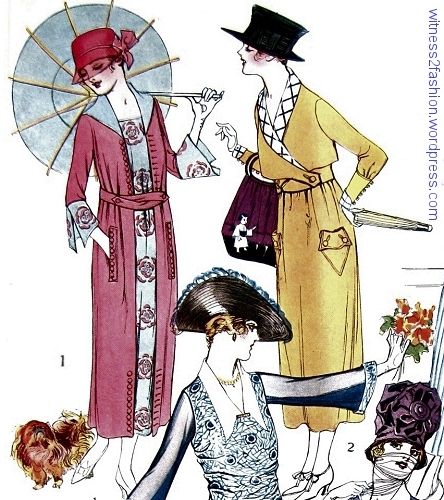
Butterick 9992 and 9447, July 1918. Delineator. Belts that crossed over and buttoned in front were a distinctive feature of the “teens.”
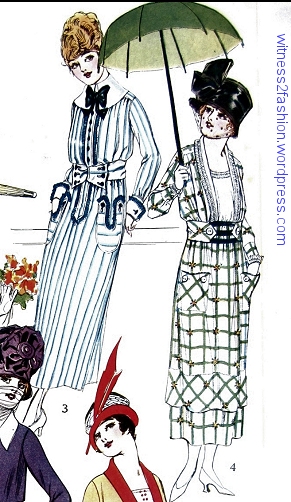
Butterick 9989 and 9990, July 1918. Delineator. The dress on the left has a “Peter Pan” collar — very different from the Peter Pan collar of the 50s.
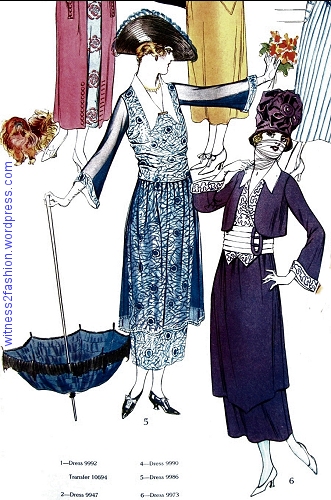
Butterick 9986 and 9973, July 1918. Delineator. There was nothing but fashion to prevent a shapely girl from wearing her belt (or her basque bodice) tighter….
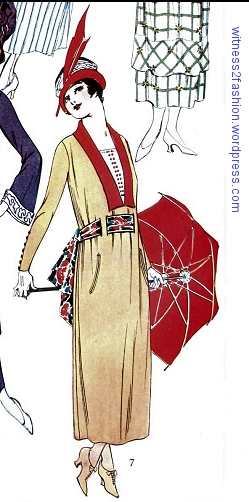
Butterick 1005, July 1918. Page 52. Delineator. That’s almost a 1920’s cloche hat.
Dress Details 1918
In case anyone is inspired to recreate these fashions, here are the original descriptions and alternate views.
The high collared blouse fell out of fashion around 1912, when bare necks became acceptable, (cf Lucy Barton, Historic Costume for the Stage) but the V-neck in daytime was a new idea in 1914, so most of these patterns show a high-necked alternative for conservative women.

Butterick 9992, July 1918. Delineator, p. 52. “For women 15 or 50.”

Butterick 9947, July 1918. Delineator, p. 52. Transfer 10686 is the pattern for the bag, which seams to have a figure in a kimono on it.
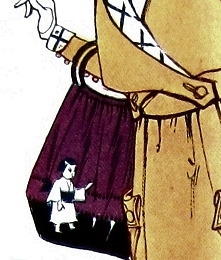
Bag, Butterick transfer pattern 10686 from 1918.

Butterick 9989, July 1918. Delineator, p. 52.

Butterick 9990, July 1918. Delineator, p. 52. A “delightful new shirt-dress.”

Left, Butterick 9986, July 1918. Delineator, p. 52. It has a side seam opening.

Butterick 9973, July 1918. Delineator, p. 52.

Butterick 1005, July 1918. Delineator, p. 52. “It slips on over the head,” like many of the 1920’s dresses that followed.

Butterick 9932, July 1918. Delineator, p. 52. Without the optional shirring, it becomes an Empire line dress. For maternity wear, perhaps?

Butterick 1035, July 1918. Delineator, p. 52. This style was available up to bust 46 inches, and the scarf-like “bretelles” end in pockets. Transfer 10674 is the embroidery design.

Butterick 1037, July 1918. Delineator, p. 52. The front panel could be asymmetrical. I’m surprised this dress is not shown without its tabard-like top layer.
More dresses in color from 1918 to come….
